Page 3448 of 4087

Diag. Code 14, 15Ignition Signal Circuit
CIRCUIT DESCRIPTION
The ECU determines the ignition timing, turns on Tr1 at a predetermined angle (5CA) before the desired
ignition timing and outputs an ignition signal (IGT) º1º to the \
igniter.
Since the width of the IGT signal is constant, the dwell angle control circuit in the ignit\
er determines the
time the control circuit starts primary current flow to the ignition coil bas\
ed on the engine rpm and ignition
timing one revolution ago, that is, the time the Tr2 turns on.
When it reaches the ignition timing, the ECU turns Tr1 off and outputs the IGT signal ºOº.
This turns Tr2 off, interrupting the primary current flow and generating a high voltage i\
n the secondary coil
which causes the spark plug to spark. Also, by the counter electromotive force\
generated when the primary
current is interrupted, the igniter sends an ignition confirmation signal (IGF\
) to the ECU.
The ECU stops fuel injection as a fail safe function when the IGF signal\
is not input to the ECU.
Code No.Diagnostic Code Detecting ConditionTrouble Area
14No IGF1 signal to ECU for 8±11 consecutive
IGT1 signal.
w Open or short in IGF1 and IGT1 circuit from
No. 1 igniter ± ECU.
w No. 1 igniter
w ECU
15No IGF2 signal to ECU for 8±11 consecutive
IGT2 signal.
wOpen or short in IGF2 and IGT2 circuit from
No. 2 igniter ± ECU.
w No. 2 igniter
w ECU
HINT: No. 1 igniter is for left bank and No. 2 igniter is for right bank.
WIRING DIAGRAM
TR±54±
ENGINE TROUBLESHOOTING Circuit Inspection
WhereEverybodyKnowsYourName
Page 3491 of 4087
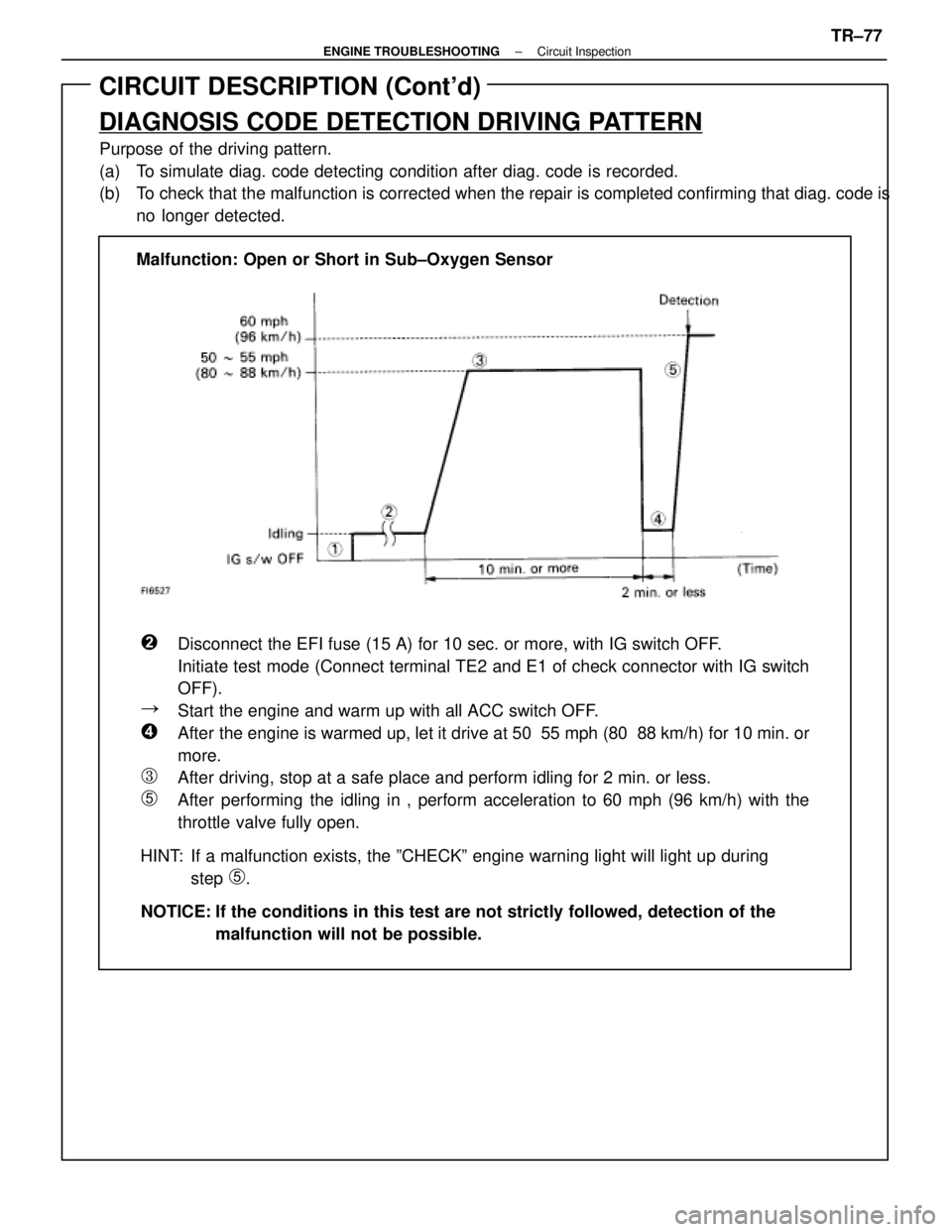
CIRCUIT DESCRIPTION (Cont'd)
DIAGNOSIS CODE DETECTION DRIVING PATTERN
Purpose of the driving pattern.
(a) To simulate diag. code detecting condition after diag. code is recorded.
(b) To check that the malfunction is corrected when the repair is completed co\
nfirming that diag. code isno longer detected.
�Disconnect the EFI fuse (15 A) for 10 sec. or more, with IG switch OFF\
.
Initiate test mode (Connect terminal TE2 and E1 of check connector with\
IG switch
OFF).
�Start the engine and warm up with all ACC switch OFF.
�After the engine is warmed up, let it drive at 50 55 mph (80 88 km/h) for\
10 min. or
more.
�After driving, stop at a safe place and perform idling for 2 min. or les\
s.
�After performing the idling in , perform acceleration to 60 mph (96 km/h) with the
throttle valve fully open.
HINT: If a malfunction exists, the ºCHECKº engine warning light will lig\
ht up during step
�.
NOTICE: If the conditions in this test are not strictly followed, detection of t\
he malfunction will not be possible.
Malfunction: Open or Short in Sub±Oxygen Sensor
±
ENGINE TROUBLESHOOTING Circuit InspectionTR±77
WhereEverybodyKnowsYourName
Page 3496 of 4087
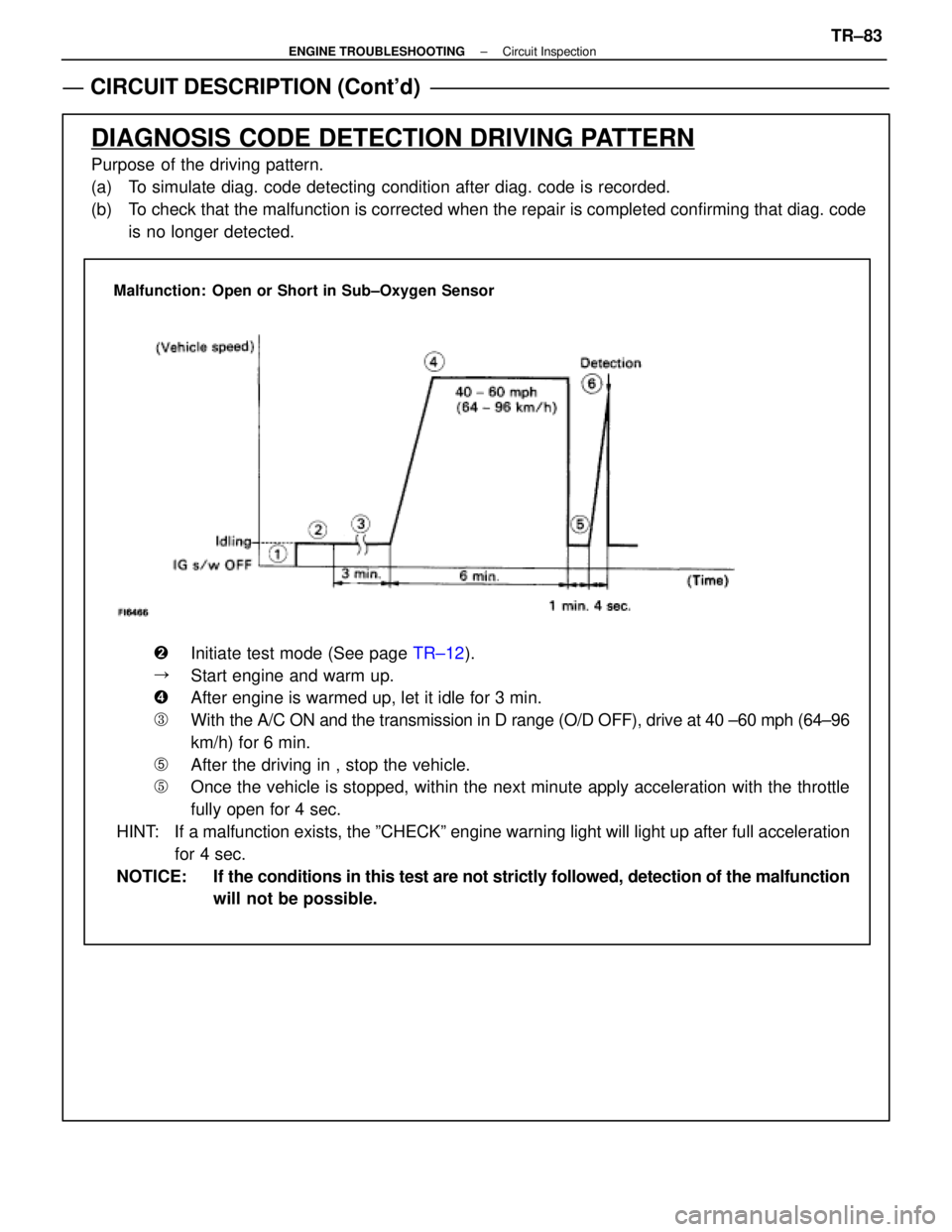
CIRCUIT DESCRIPTION (Cont'd)
DIAGNOSIS CODE DETECTION DRIVING PATTERN
Purpose of the driving pattern.
(a) To simulate diag. code detecting condition after diag. code is recorded.
(b) To check that the malfunction is corrected when the repair is completed co\
nfirming that diag. codeis no longer detected.
Malfunction: Open or Short in Sub±Oxygen Sensor
�Initiate test mode (See page TR±12).
�Start engine and warm up.
�After engine is warmed up, let it idle for 3 min.
�With the A/C ON and the transmission in D range (O/D OFF), drive at 40 ±\
60 mph (64±96
km/h) for 6 min.
�After the driving in , stop the vehicle.
�Once the vehicle is stopped, within the next minute apply acceleration w\
ith the throttle
fully open for 4 sec.
HINT: If a malfunction exists, the ºCHECKº engine warning light will light\
up after full acceleration for 4 sec.
NOTICE: If the conditions in this test are not strictly followed, detection of the\
malfunction will not be possible.
±
ENGINE TROUBLESHOOTING Circuit InspectionTR±83
WhereEverybodyKnowsYourName
Page 3574 of 4087

Cold Start Injector Circuit
CIRCUIT DESCRIPTION
The cold start injector is used to maintain the engine startability when it\
is cold. The injection volume, i,e, the
length of time the injector is energized, is controlled by the ECU and t\
he cold start injector time switch.
During a cold start, when the starter turns the contacts in the cold start inj\
ector time switch close. Thus current
flows to the cold start injector coil, injecting fuel. At the same time, a bi\
metal in the heat coil is energized and
heats up. This soon causes the contacts to open, cutting off the current flow to the injector coil and stopping
fuel injection.
The injection duration of the cold start injector is determined by the cool\
ant temperature and the length of time
current flows to the heat coil. When the engine is warm, the contacts are opened by the bimetal and the cold
start injector does not operate.
When the engine is hard to start and the starter is operated continuously, heat coil (2) heats up the bimetal keep-
ing the contacts open to prevent spark plugs from becoming fouled, which is\
caused by the cold start injector
operation when the open contacts close again.
When the engine is started at a coolant temperature of 225C (72 5F) or lower, the cold start injector operation
time is controlled by the cold start injector time switch.
When the coolant temperature is in the normal temperature range 22 5C (72 5F) or higher, the contacts of the cold
start injector time switch are open and the time switch is off, instead, the ECU controls the operating time of the
cold start injector.
In this way, the CO and HC levels can be reduced while the engine is being started \
and the engine startability
is maintained. Control by the ECU ends when the coolant temperature reac\
hes 60 5C (140 5F).
TR±136±
ENGINE TROUBLESHOOTING Circuit Inspection
WhereEverybodyKnowsYourName
Page 3609 of 4087
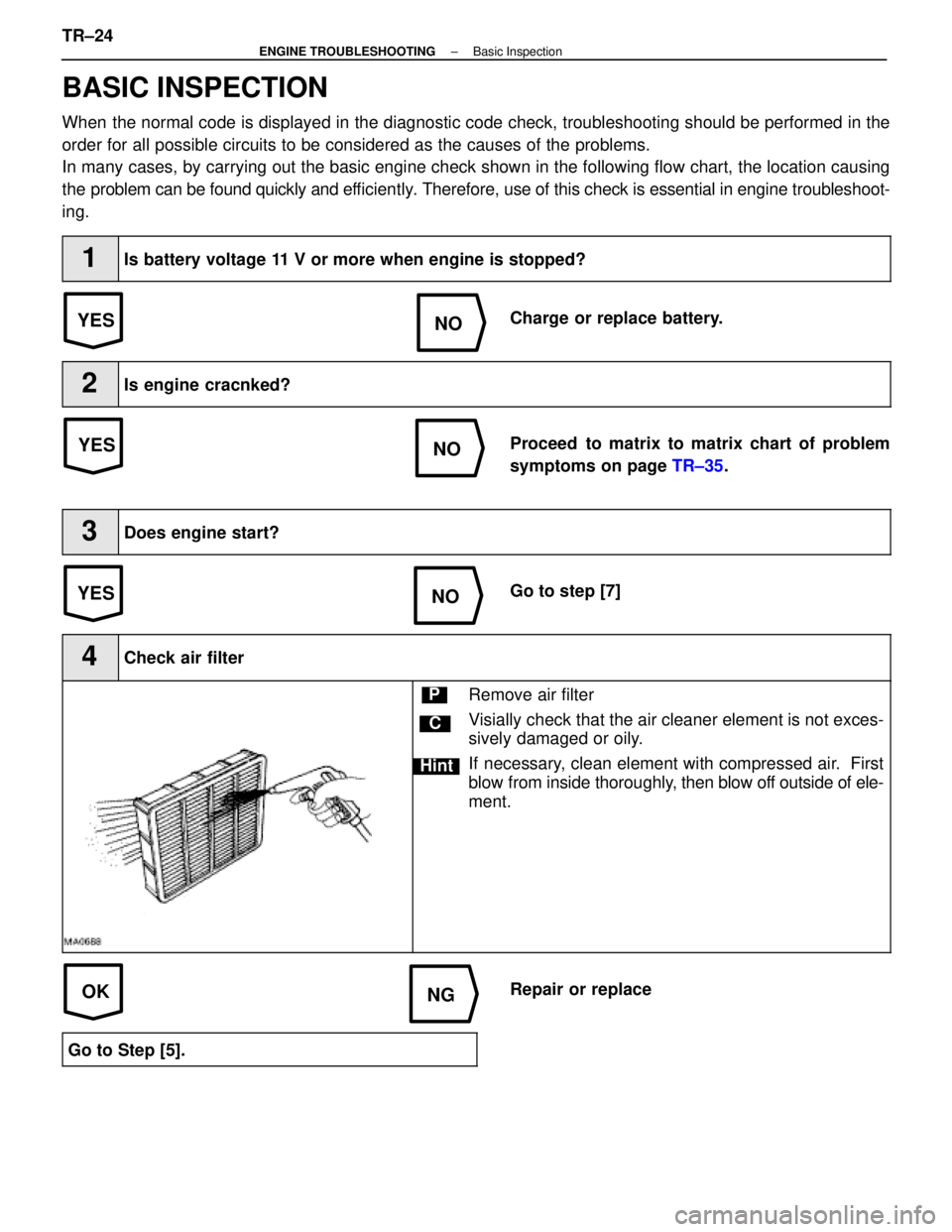
YESNO
NOYES
YES
NO
OKNG
BASIC INSPECTION
When the normal code is displayed in the diagnostic code check, troubleshoot\
ing should be performed in the
order for all possible circuits to be considered as the causes of the pr\
oblems.
In many cases, by carrying out the basic engine check shown in the follo\
wing flow chart, the location causing
the problem can be found quickly and ef ficiently. Therefore, use of this check is essential in engine troubleshoot-
ing.
1Is battery voltage 11 V or more when engine is stopped?
Charge or replace battery.
2Is engine cracnked?
Proceed to matrix to matrix chart of problem
symptoms on page TR±35.
3Does engine start?
Go to step [7]
4Check air filter
C
Hint
PRemove air filter
Visially check that the air cleaner element is not exces-
sively damaged or oily.
If necessary, clean element with compressed air. First
blow from inside thoroughly, then blow off outside of ele-
ment.
Repair or replace
Go to Step [5].
TR±24±
ENGINE TROUBLESHOOTING Basic Inspection
WhereEverybodyKnowsYourName
Page 3660 of 4087
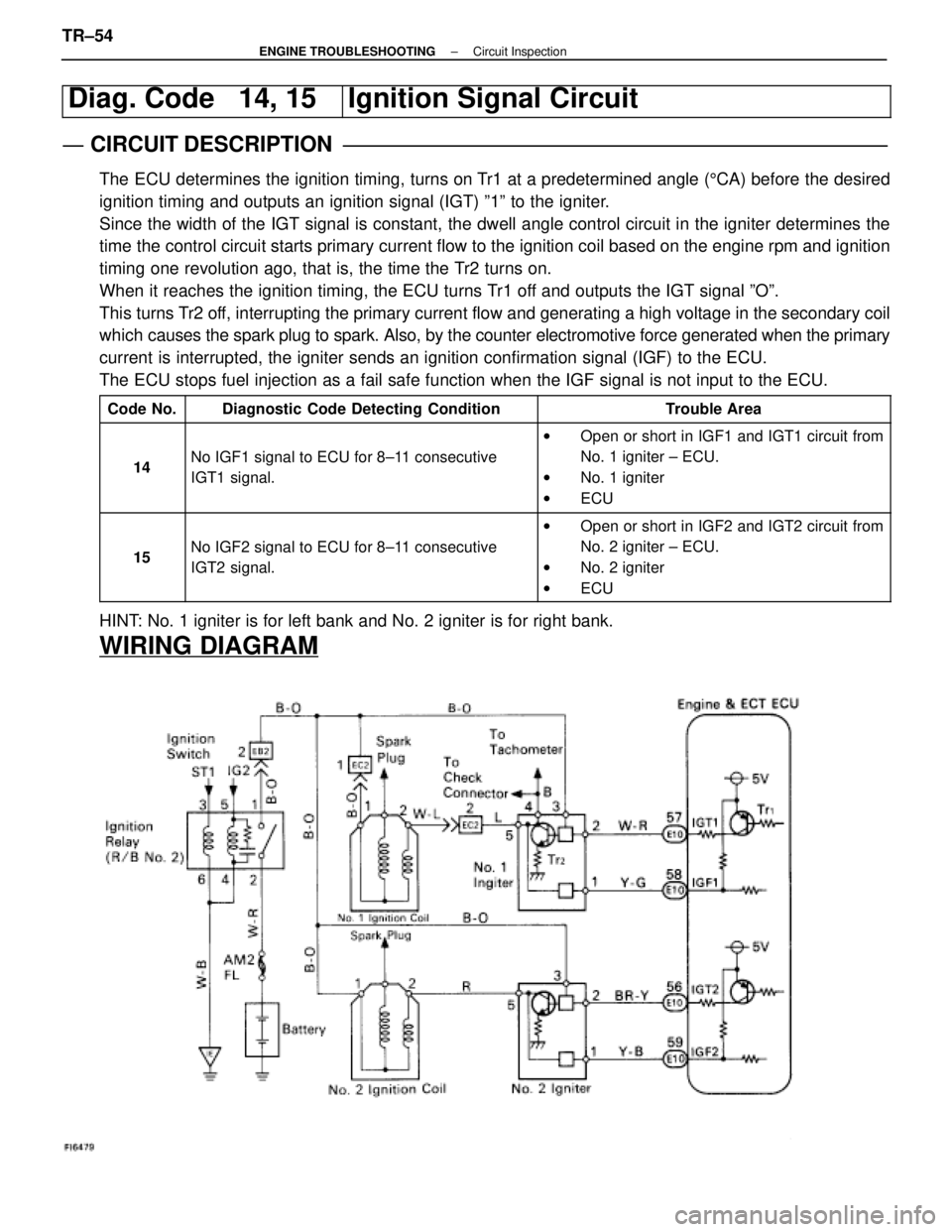
Diag. Code 14, 15Ignition Signal Circuit
CIRCUIT DESCRIPTION
The ECU determines the ignition timing, turns on Tr1 at a predetermined angle (5CA) before the desired
ignition timing and outputs an ignition signal (IGT) º1º to the \
igniter.
Since the width of the IGT signal is constant, the dwell angle control circuit in the ignit\
er determines the
time the control circuit starts primary current flow to the ignition coil bas\
ed on the engine rpm and ignition
timing one revolution ago, that is, the time the Tr2 turns on.
When it reaches the ignition timing, the ECU turns Tr1 off and outputs the IGT signal ºOº.
This turns Tr2 off, interrupting the primary current flow and generating a high voltage i\
n the secondary coil
which causes the spark plug to spark. Also, by the counter electromotive force\
generated when the primary
current is interrupted, the igniter sends an ignition confirmation signal (IGF\
) to the ECU.
The ECU stops fuel injection as a fail safe function when the IGF signal\
is not input to the ECU.
Code No.Diagnostic Code Detecting ConditionTrouble Area
14No IGF1 signal to ECU for 8±11 consecutive
IGT1 signal.
w Open or short in IGF1 and IGT1 circuit from
No. 1 igniter ± ECU.
w No. 1 igniter
w ECU
15No IGF2 signal to ECU for 8±11 consecutive
IGT2 signal.
wOpen or short in IGF2 and IGT2 circuit from
No. 2 igniter ± ECU.
w No. 2 igniter
w ECU
HINT: No. 1 igniter is for left bank and No. 2 igniter is for right bank.
WIRING DIAGRAM
TR±54±
ENGINE TROUBLESHOOTING Circuit Inspection
WhereEverybodyKnowsYourName
Page 3703 of 4087

CIRCUIT DESCRIPTION (Cont'd)
DIAGNOSIS CODE DETECTION DRIVING PATTERN
Purpose of the driving pattern.
(a) To simulate diag. code detecting condition after diag. code is recorded.
(b) To check that the malfunction is corrected when the repair is completed co\
nfirming that diag. code isno longer detected.
�Disconnect the EFI fuse (15 A) for 10 sec. or more, with IG switch OFF\
.
Initiate test mode (Connect terminal TE2 and E1 of check connector with\
IG switch
OFF).
�Start the engine and warm up with all ACC switch OFF.
�After the engine is warmed up, let it drive at 50 55 mph (80 88 km/h) for\
10 min. or
more.
�After driving, stop at a safe place and perform idling for 2 min. or les\
s.
�After performing the idling in , perform acceleration to 60 mph (96 km/h) with the
throttle valve fully open.
HINT: If a malfunction exists, the ºCHECKº engine warning light will lig\
ht up during step
�.
NOTICE: If the conditions in this test are not strictly followed, detection of t\
he malfunction will not be possible.
Malfunction: Open or Short in Sub±Oxygen Sensor
±
ENGINE TROUBLESHOOTING Circuit InspectionTR±77
WhereEverybodyKnowsYourName
Page 3708 of 4087
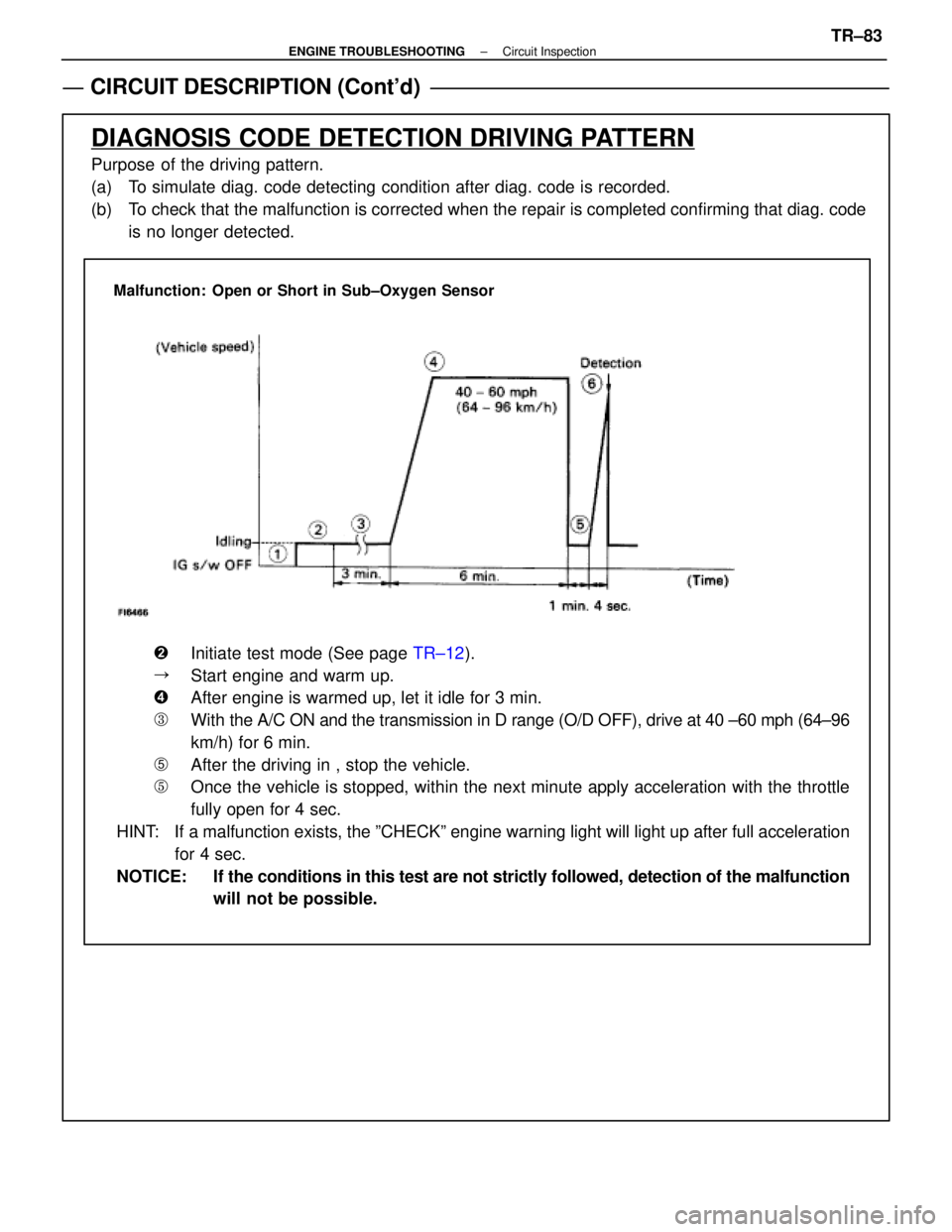
CIRCUIT DESCRIPTION (Cont'd)
DIAGNOSIS CODE DETECTION DRIVING PATTERN
Purpose of the driving pattern.
(a) To simulate diag. code detecting condition after diag. code is recorded.
(b) To check that the malfunction is corrected when the repair is completed co\
nfirming that diag. codeis no longer detected.
Malfunction: Open or Short in Sub±Oxygen Sensor
�Initiate test mode (See page TR±12).
�Start engine and warm up.
�After engine is warmed up, let it idle for 3 min.
�With the A/C ON and the transmission in D range (O/D OFF), drive at 40 ±\
60 mph (64±96
km/h) for 6 min.
�After the driving in , stop the vehicle.
�Once the vehicle is stopped, within the next minute apply acceleration w\
ith the throttle
fully open for 4 sec.
HINT: If a malfunction exists, the ºCHECKº engine warning light will light\
up after full acceleration for 4 sec.
NOTICE: If the conditions in this test are not strictly followed, detection of the\
malfunction will not be possible.
±
ENGINE TROUBLESHOOTING Circuit InspectionTR±83
WhereEverybodyKnowsYourName